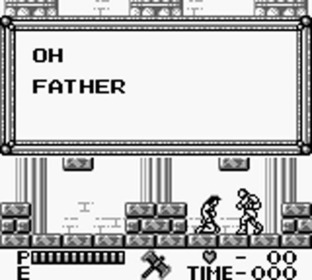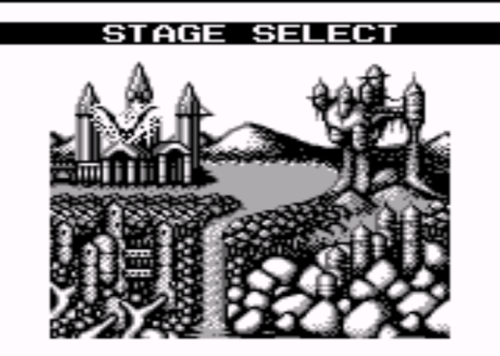Castlevania II: Belmont’s Revenge – Game Boy
 Platform: Game Boy
Platform: Game Boy
Developer: Konami
Publisher: Konami
Release Date (NA): August 1991
Genre: Action / Adventure, Platformer
Nerd Rating: 8 out of 10
Just 2 years after the lukewarm Castlevania: The Adventure, Konami would turn out what would end up being one of the more memorable achievements for the original Game Boy. With a much needed update to gameplay and graphics, Castlevania: Belmont’s Revenge does a terrific job at making the most of the Game Boy’s limited technology. Once again I used a GBA and Game Boy Player to make my way through the game, along with a GameShark Pro which you can read more about in my review for the preceding title.
 Set fifteen years after Christopher Belmont’s first conflict with Dracula, Christopher celebrates his son Soleiyu’s “coming of age feast.” Through some manner of the black arts, Dracula is about to capture Soleiyu and transform him into a demon. Somehow this act allows Dracula to retake his “human” form (leaving one to wonder how the hell he kidnapped Soleiyu in the first place…) and he is now free to rebuild his castle. Populating his domicile with creatures of the night once again, Dracula sets out to stomp out the Belmont line or plunge the world into darkness or do whatever it is he tries to do. Daddy’s pissed, and our story gets underway.
Set fifteen years after Christopher Belmont’s first conflict with Dracula, Christopher celebrates his son Soleiyu’s “coming of age feast.” Through some manner of the black arts, Dracula is about to capture Soleiyu and transform him into a demon. Somehow this act allows Dracula to retake his “human” form (leaving one to wonder how the hell he kidnapped Soleiyu in the first place…) and he is now free to rebuild his castle. Populating his domicile with creatures of the night once again, Dracula sets out to stomp out the Belmont line or plunge the world into darkness or do whatever it is he tries to do. Daddy’s pissed, and our story gets underway.

Like Adventure, Belmont’s Revenge is not without its shortcomings, but its improvements are immediately noticeable as well. The game is still relatively short, Christopher is still a little slow-moving (though not nearly as immobile as in the previous title, in my opinion), and we still have a general departure from what’s common on console entries in the series. Many of the same enemies reappear, though the stages have been given a complete overhaul with distinct thematic elements and immensely more creative bosses. Sub-weapons have been brought back (albeit in a limited fashion), ropes still replace stairways though Christopher can now attack while on the rope, and difficulty has been curtailed to a more progressive approach rather than the hard shift in Adventure.
 In the second Castlevania installment for the Game Boy, the game world is divided into 4 stages with a fifth and sixth becoming available after the others are completed. Unique for a Castlevania game, the player has the option of deciding in what order to visit the levels. Dubbed “The Crystal Castle,” “The Plant Castle,” “The Rock Castle,” and “The Cloud Castle,” each level has its own visual style. The final two stages are two halves of Dracula’s Castle where our hero first faces off against something similar to a skeleton version of the Orphic Vipers from Super Castlevania IV. Christopher’s penultimate battle is with his “demonized” son, followed immediately by the final showdown against Dracula himself.
In the second Castlevania installment for the Game Boy, the game world is divided into 4 stages with a fifth and sixth becoming available after the others are completed. Unique for a Castlevania game, the player has the option of deciding in what order to visit the levels. Dubbed “The Crystal Castle,” “The Plant Castle,” “The Rock Castle,” and “The Cloud Castle,” each level has its own visual style. The final two stages are two halves of Dracula’s Castle where our hero first faces off against something similar to a skeleton version of the Orphic Vipers from Super Castlevania IV. Christopher’s penultimate battle is with his “demonized” son, followed immediately by the final showdown against Dracula himself.

 Each castle is beautiful in its own low tech way, and again it is the backgrounds that truly shine. Yet again I viewed this title via the color imposition of the GBA and Game Boy Player and while the blues and greens are surely more pleasing than the grays and blacks of the original, it’s still impressive how much thought and attention was given to each of the tiny screens. Bosses are far superior in both appearance and concept than those of Adventure and while they still don’t quite hit the highs of console releases, they should suffice for players who have adjusted their expectations accordingly.
Each castle is beautiful in its own low tech way, and again it is the backgrounds that truly shine. Yet again I viewed this title via the color imposition of the GBA and Game Boy Player and while the blues and greens are surely more pleasing than the grays and blacks of the original, it’s still impressive how much thought and attention was given to each of the tiny screens. Bosses are far superior in both appearance and concept than those of Adventure and while they still don’t quite hit the highs of console releases, they should suffice for players who have adjusted their expectations accordingly.

 Whether or not Christopher is able to move any faster or if the control is really any better than the previous game is up for debate. One thing is certain though; even if Konami wasn’t able to improve upon these aspects, they’ve at least done a better job of designing levels that work with these limitations rather than exploiting them. Belmont’s Revenge is still a challenging game, but not because our hero can’t move fast enough or jump far enough. There are a huge variety of obstacles, from simple enemy hordes to complicated series of rope-jumping (those involving the spider webs are quite inventive) to carefully timed jumps across small platforms and crumbling stones, and all of it is very much doable without having to find that one perfect millisecond to execute. The ability to use the whip to attack while clinging to a rope is itself a single-handed game-changer.
Whether or not Christopher is able to move any faster or if the control is really any better than the previous game is up for debate. One thing is certain though; even if Konami wasn’t able to improve upon these aspects, they’ve at least done a better job of designing levels that work with these limitations rather than exploiting them. Belmont’s Revenge is still a challenging game, but not because our hero can’t move fast enough or jump far enough. There are a huge variety of obstacles, from simple enemy hordes to complicated series of rope-jumping (those involving the spider webs are quite inventive) to carefully timed jumps across small platforms and crumbling stones, and all of it is very much doable without having to find that one perfect millisecond to execute. The ability to use the whip to attack while clinging to a rope is itself a single-handed game-changer.

 Finally, one of the most surprising elements of Castlevania II: Belmont’s Revenge is the sound and music quality. I think it’s fair to say that most people can be extremely forgiving when it comes to sound quality and musical variety on the Game Boy. After all, most games for portable systems are designed with the idea that players may not be able to have the sound on at all times. Belmont’s Revenge may not completely shatter these preconceptions, but it comes damn close. Sounds are extremely clear and distinct, and also of a wide variety. There are different and recognizable sounds to indicate the acquisition of a whip upgrade, the loss of an upgrade, receiving damage without losing an upgrade, throwing each of the two sub-weapons (axe and holy water), and nearly every other occurrence resulting in a sound effect. Belmont’s Revenge doesn’t rely on the recycling of effects at all, a somewhat unusual feature for early handhelds.
Finally, one of the most surprising elements of Castlevania II: Belmont’s Revenge is the sound and music quality. I think it’s fair to say that most people can be extremely forgiving when it comes to sound quality and musical variety on the Game Boy. After all, most games for portable systems are designed with the idea that players may not be able to have the sound on at all times. Belmont’s Revenge may not completely shatter these preconceptions, but it comes damn close. Sounds are extremely clear and distinct, and also of a wide variety. There are different and recognizable sounds to indicate the acquisition of a whip upgrade, the loss of an upgrade, receiving damage without losing an upgrade, throwing each of the two sub-weapons (axe and holy water), and nearly every other occurrence resulting in a sound effect. Belmont’s Revenge doesn’t rely on the recycling of effects at all, a somewhat unusual feature for early handhelds.
The music is another high point of the game. Sure, it does utilize some repetition, but the melodies are unique for each castle as well as the boss portion of each castle. I’m not sure if it quite makes it all the way to “catchy,” but it is memorable and engaging and manages to do a pretty good job of not being totally monotonous. It’s debatable how much of the synth herein is suited to the environment though it will grab almost anyone’s attention with the volume at a reasonable level. My personal favorite are the deep, fuzzy, analog bass notes signaling doom in a most effective fashion just before the father and son throw down. (Think of the deep, muted, pitch-shifted brass from the film Inception.)
 I don’t mean to get anyone’s hopes up – this is still a Game Boy game after all – but it’s about as amazing as a Game Boy title can be. Graphics, gameplay, and the oft-ignored sound all taken into account, only a few heavyweights (a la Mario, Kirby) can even begin to stand up to Castlevania II: Belmont’s Revenge. Most importantly perhaps is the major improvement over its predecessor, a characteristic that’s always admired and not always easy to pull off. How many sequels can you truly point at and claim that every single change was warranted, needed, and appreciated? This is one of them!
I don’t mean to get anyone’s hopes up – this is still a Game Boy game after all – but it’s about as amazing as a Game Boy title can be. Graphics, gameplay, and the oft-ignored sound all taken into account, only a few heavyweights (a la Mario, Kirby) can even begin to stand up to Castlevania II: Belmont’s Revenge. Most importantly perhaps is the major improvement over its predecessor, a characteristic that’s always admired and not always easy to pull off. How many sequels can you truly point at and claim that every single change was warranted, needed, and appreciated? This is one of them!
Reviewed by The Cubist
Share This Post
3 Comments








Pingback: Castlevania: The Adventure - Game Boy - Nerd Bacon Reviews
Pingback: Castlevania Legends - Game Boy - Nerd Bacon Reviews
Pingback: Nerd Bacon Celebrates Retroary! (Retro + February = Retroary) - Nerd Bacon Reviews